| Algebraic structure → Group theory Group theory | ||||||
|---|---|---|---|---|---|---|
 | ||||||
Basic notions
|
||||||
Finite groups
|
||||||
Modular groups
|
||||||
Topological and Lie groups
|
||||||
| Algebraic groups | ||||||
In group theory, a branch of mathematics, a subset of a group G is a subgroup of G if the members of that subset form a group with respect to the group operation in G.
Formally, given a group G under a binary operation ∗, a subset H of G is called a subgroup of G if H also forms a group under the operation ∗. More precisely, H is a subgroup of G if the restriction of ∗ to H × H is a group operation on H. This is often denoted H ≤ G, read as "H is a subgroup of G".
The trivial subgroup of any group is the subgroup {e} consisting of just the identity element.
A proper subgroup of a group G is a subgroup H which is a proper subset of G (that is, H ≠ G). This is often represented notationally by H < G, read as "H is a proper subgroup of G". Some authors also exclude the trivial group from being proper (that is, H ≠ {e}).
If H is a subgroup of G, then G is sometimes called an overgroup of H.
The same definitions apply more generally when G is an arbitrary semigroup, but this article will only deal with subgroups of groups.
Subgroup tests
Suppose that G is a group, and H is a subset of G. For now, assume that the group operation of G is written multiplicatively, denoted by juxtaposition.
- Then H is a subgroup of G if and only if H is nonempty and closed under products and inverses. Closed under products means that for every a and b in H, the product ab is in H. Closed under inverses means that for every a in H, the inverse a is in H. These two conditions can be combined into one, that for every a and b in H, the element ab is in H, but it is more natural and usually just as easy to test the two closure conditions separately.
- When H is finite, the test can be simplified: H is a subgroup if and only if it is nonempty and closed under products. These conditions alone imply that every element a of H generates a finite cyclic subgroup of H, say of order n, and then the inverse of a is a.
If the group operation is instead denoted by addition, then closed under products should be replaced by closed under addition, which is the condition that for every a and b in H, the sum a + b is in H, and closed under inverses should be edited to say that for every a in H, the inverse −a is in H.
Basic properties of subgroups
- The identity of a subgroup is the identity of the group: if G is a group with identity eG, and H is a subgroup of G with identity eH, then eH = eG.
- The inverse of an element in a subgroup is the inverse of the element in the group: if H is a subgroup of a group G, and a and b are elements of H such that ab = ba = eH, then ab = ba = eG.
- If H is a subgroup of G, then the inclusion map H → G sending each element a of H to itself is a homomorphism.
- The intersection of subgroups A and B of G is again a subgroup of G. For example, the intersection of the x-axis and y-axis in under addition is the trivial subgroup. More generally, the intersection of an arbitrary collection of subgroups of G is a subgroup of G.
- The union of subgroups A and B is a subgroup if and only if A ⊆ B or B ⊆ A. A non-example: is not a subgroup of because 2 and 3 are elements of this subset whose sum, 5, is not in the subset. Similarly, the union of the x-axis and the y-axis in is not a subgroup of
- If S is a subset of G, then there exists a smallest subgroup containing S, namely the intersection of all of subgroups containing S; it is denoted by ⟨S⟩ and is called the subgroup generated by S. An element of G is in ⟨S⟩ if and only if it is a finite product of elements of S and their inverses, possibly repeated.
- Every element a of a group G generates a cyclic subgroup ⟨a⟩. If ⟨a⟩ is isomorphic to (the integers mod n) for some positive integer n, then n is the smallest positive integer for which a = e, and n is called the order of a. If ⟨a⟩ is isomorphic to then a is said to have infinite order.
- The subgroups of any given group form a complete lattice under inclusion, called the lattice of subgroups. (While the infimum here is the usual set-theoretic intersection, the supremum of a set of subgroups is the subgroup generated by the set-theoretic union of the subgroups, not the set-theoretic union itself.) If e is the identity of G, then the trivial group {e} is the minimum subgroup of G, while the maximum subgroup is the group G itself.

Cosets and Lagrange's theorem
Main articles: Coset and Lagrange's theorem (group theory)Given a subgroup H and some a in G, we define the left coset aH = {ah : h in H}. Because a is invertible, the map φ : H → aH given by φ(h) = ah is a bijection. Furthermore, every element of G is contained in precisely one left coset of H; the left cosets are the equivalence classes corresponding to the equivalence relation a1 ~ a2 if and only if is in H. The number of left cosets of H is called the index of H in G and is denoted by .
Lagrange's theorem states that for a finite group G and a subgroup H,
where |G| and |H| denote the orders of G and H, respectively. In particular, the order of every subgroup of G (and the order of every element of G) must be a divisor of |G|.
Right cosets are defined analogously: Ha = {ha : h in H}. They are also the equivalence classes for a suitable equivalence relation and their number is equal to .
If aH = Ha for every a in G, then H is said to be a normal subgroup. Every subgroup of index 2 is normal: the left cosets, and also the right cosets, are simply the subgroup and its complement. More generally, if p is the lowest prime dividing the order of a finite group G, then any subgroup of index p (if such exists) is normal.
Example: Subgroups of Z8
Let G be the cyclic group Z8 whose elements are
and whose group operation is addition modulo 8. Its Cayley table is
| + | 0 | 4 | 2 | 6 | 1 | 5 | 3 | 7 |
|---|---|---|---|---|---|---|---|---|
| 0 | 0 | 4 | 2 | 6 | 1 | 5 | 3 | 7 |
| 4 | 4 | 0 | 6 | 2 | 5 | 1 | 7 | 3 |
| 2 | 2 | 6 | 4 | 0 | 3 | 7 | 5 | 1 |
| 6 | 6 | 2 | 0 | 4 | 7 | 3 | 1 | 5 |
| 1 | 1 | 5 | 3 | 7 | 2 | 6 | 4 | 0 |
| 5 | 5 | 1 | 7 | 3 | 6 | 2 | 0 | 4 |
| 3 | 3 | 7 | 5 | 1 | 4 | 0 | 6 | 2 |
| 7 | 7 | 3 | 1 | 5 | 0 | 4 | 2 | 6 |
This group has two nontrivial subgroups: ■ J = {0, 4} and ■ H = {0, 4, 2, 6} , where J is also a subgroup of H. The Cayley table for H is the top-left quadrant of the Cayley table for G; The Cayley table for J is the top-left quadrant of the Cayley table for H. The group G is cyclic, and so are its subgroups. In general, subgroups of cyclic groups are also cyclic.
Example: Subgroups of S4
S4 is the symmetric group whose elements correspond to the permutations of 4 elements.
Below are all its subgroups, ordered by cardinality.
Each group (except those of cardinality 1 and 2) is represented by its Cayley table.
24 elements
Like each group, S4 is a subgroup of itself.
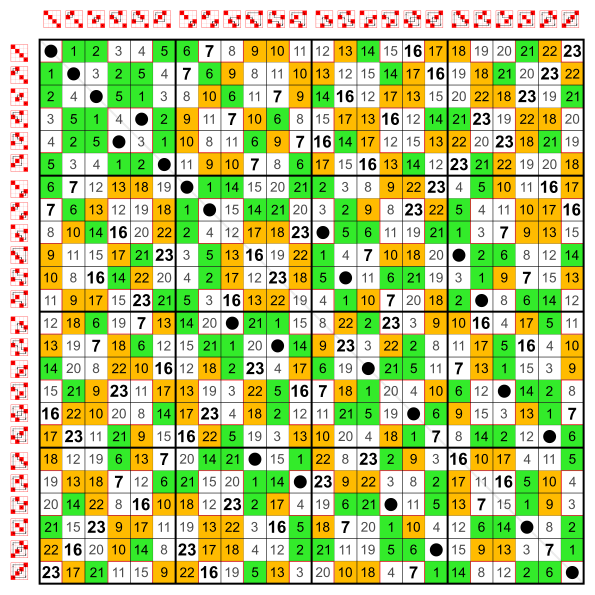 |
 All 30 subgroups All 30 subgroups SimplifiedHasse diagrams of the lattice of subgroups of S4 SimplifiedHasse diagrams of the lattice of subgroups of S4
|
12 elements
The alternating group contains only the even permutations.
It is one of the two nontrivial proper normal subgroups of S4. (The other one is its Klein subgroup.)

Subgroups:





8 elements
 Subgroups:    |
 Subgroups:    |
 Subgroups:    |
6 elements
 Subgroup:  |
 Subgroup:  |
 Subgroup:  |
 Subgroup:  |
4 elements
 |
 |
 |
 (normal subgroup) |
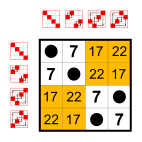 |
 |
 |
3 elements
 |
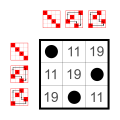 |
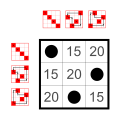 |
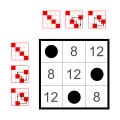 |
2 elements
Each permutation p of order 2 generates a subgroup {1, p}.
These are the permutations that have only 2-cycles:
- There are the 6 transpositions with one 2-cycle. (green background)
- And 3 permutations with two 2-cycles. (white background, bold numbers)
1 element
The trivial subgroup is the unique subgroup of order 1.
Other examples
- The even integers form a subgroup of the integer ring the sum of two even integers is even, and the negative of an even integer is even.
- An ideal in a ring R is a subgroup of the additive group of R.
- A linear subspace of a vector space is a subgroup of the additive group of vectors.
- In an abelian group, the elements of finite order form a subgroup called the torsion subgroup.
See also
Notes
- Gallian 2013, p. 61.
- Hungerford 1974, p. 32.
- Artin 2011, p. 43.
- ^ Kurzweil & Stellmacher 1998, p. 4.
- Jacobson 2009, p. 41.
- Ash 2002.
- See a didactic proof in this video.
- Dummit & Foote 2004, p. 90.
- Gallian 2013, p. 81.
References
- Jacobson, Nathan (2009), Basic algebra, vol. 1 (2nd ed.), Dover, ISBN 978-0-486-47189-1.
- Hungerford, Thomas (1974), Algebra (1st ed.), Springer-Verlag, ISBN 9780387905181.
- Artin, Michael (2011), Algebra (2nd ed.), Prentice Hall, ISBN 9780132413770.
- Dummit, David S.; Foote, Richard M. (2004). Abstract algebra (3rd ed.). Hoboken, NJ: Wiley. ISBN 9780471452348. OCLC 248917264.
- Gallian, Joseph A. (2013). Contemporary abstract algebra (8th ed.). Boston, MA: Brooks/Cole Cengage Learning. ISBN 978-1-133-59970-8. OCLC 807255720.
- Kurzweil, Hans; Stellmacher, Bernd (1998). Theorie der endlichen Gruppen. Springer-Lehrbuch. doi:10.1007/978-3-642-58816-7. ISBN 978-3-540-60331-3.
- Ash, Robert B. (2002). Abstract Algebra: The Basic Graduate Year. Department of Mathematics University of Illinois.
| Groups | |
|---|---|
| Basic notions | |
| Types of groups | |
| Discrete groups |
|
| Lie groups |
|
| Infinite dimensional groups |
|
 )
) under addition is the trivial subgroup. More generally, the intersection of an arbitrary collection of subgroups of G is a subgroup of G.
under addition is the trivial subgroup. More generally, the intersection of an arbitrary collection of subgroups of G is a subgroup of G. is not a subgroup of
is not a subgroup of  because 2 and 3 are elements of this subset whose sum, 5, is not in the subset. Similarly, the union of the x-axis and the y-axis in
because 2 and 3 are elements of this subset whose sum, 5, is not in the subset. Similarly, the union of the x-axis and the y-axis in 
 (
( the
the  There are four left cosets of H: H itself, 1 + H, 2 + H, and 3 + H (written using additive notation since this is an
There are four left cosets of H: H itself, 1 + H, 2 + H, and 3 + H (written using additive notation since this is an  is in H. The number of left cosets of H is called the
is in H. The number of left cosets of H is called the 

 of the
of the  the sum of two even integers is even, and the negative of an even integer is even.
the sum of two even integers is even, and the negative of an even integer is even.